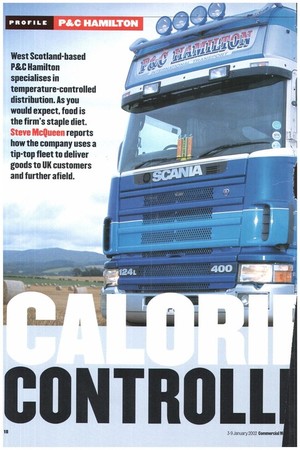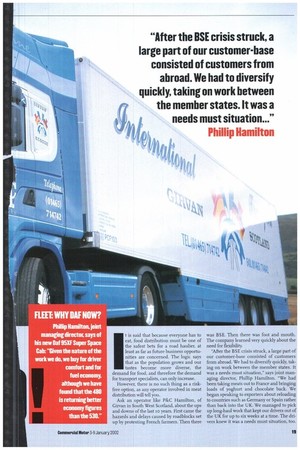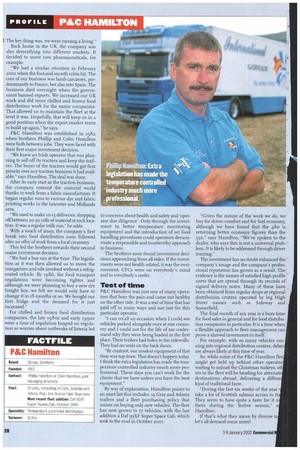C O NT It 0 I. I. 1 t is said
Page 18

Page 19

Page 20

If you've noticed an error in this article please click here to report it so we can fix it.
that because everyone has to eat, food distribution must be one of the safest bets for a road haulier, at least as far as future business opportunities are concerned. The logic says that as the population grows and our tastes become more diverse, the
demand for food, and therefore the demand for transport specialists, can only increase.
However, there is no such thing as a risk free option, as any operator involved in meat distribution will tell you.
Ask an operator like PFE.0 Hamilton, of Girvan in South West Scotland, about the ups and downs of the last itp years. First came the hazards and delays caused by roadblocks set up by protesting French farmers. Then there
was BSE. Then there was foot and mouth. The company learned very quickly about the need for flexibility.
"After the BSE crisis struck, a large part of our customer-base consisted of customers from abroad. We had to diversify quickly, taking on work between the member states. It was a needs must situation," says joint managing director, Phillip Hamilton. "We had been taking meats out to France and bringing loads of yoghurt and chocolate back. We began speaking to exporters about reloading to countries such as Germany or Spain rather than back into the U K. We managed to pick up long-haul work that kept our drivers out of the UK for up to six weeks at a time. The drivers knew it was a needs must situation, too. The key thing was, we were earning a living."
Back home in the UK, the company was also diversifying into different markets. It decided to move into pharmaceuticals, for example.
"We had a similar situation in February 2001 when the foot-and-mouth crisis hit. The core of our business was lamb carcasses, predominantly to France, but also into Spain. The business died overnight when the government banned exports. We increased our UK work and did more chilled and frozen food distribution work for the major companies. That allowed us to maintain the fleet at the level it was. Hopefully, that will keep us in a good position when the export market starts to build up again," he says.
P&C Hamilton was established in 1982 when brothers Phillip and Colin Hamilton were both between jobs. They were faced with their first major investment decision.
"We knew an Irish operator that was planning to sell off its tractors and keep the trailers. The buyer of the tractors would get first priority over any traction business it had available," says Hamilton. The deal was done.
After its early start in the traction business, the company entered the material world thanks to work from a fabric manufacturer. It began regular runs to various dye and fabric printing works in the Leicester and Midlands area.
"We used to make 10-15 deliveries, dropping off between 20-30 rolls of material at each location. It was a regular milk run," he adds.
With a touch of irony, the company's first break into food distribution soon followed after an offer of work from a local creamery.
This led the brothers towards their second major investment decision.
"We had a box van at the time. The legislation as it was then allowed us to move the margarines and oils involved without a refrigerated vehicle. By 1986, the food transport regulations were becoming tighter and although we were planning to buy a new dry freight box, we felt we would only have to change it in 18 months or so. We bought our first fridge and the demand for it just increased."
For chilled and frozen food distribution companies, the late 1980s and early 1990s were a time of regulation heaped on regulation as worries about outbreaks of listeria led to concerns about health and safety and 'operator due diligence'. Only through the investment in better temperature monitoring equipment and the introduction of set food handling procedures could operators demonstrate a responsible and trustworthy approach to business.
The brothers soon found investment decisions approaching from all sides. If the investments were not health related, it was the environment. CFCs were on everybody's mind and in everybody's reefer.
Test of time
P&C Hamilton was just one of many operators that bore the pain and came out healthy on the other side. It was a test of time that has paid off in many ways and not just for this particular operator.
"I can recall an occasion when I could see vehicles parked alongside ours at one creamery and I could not for the life of me understand why they were being loaded in the first place. Their trailers had holes in the sidewalls. They had no seals on the back doors.
"By contrast, our modest equipment of that time was top draw. That doesn't happen today. I think the extra legislation has made the temperature controlled industry much more professional. These days you can't work for the clients that we have unless you have the best equipment."
By way of explanation, Hamilton points to an asset list that includes 19 Gray and Adams trailers and a fleet purchasing policy that insists on buying only new vehicles. The fleet has now grown to 17 vehicles, with the last addition a Daf 95XF Super Space Cab, which took to the road in October zoor.
"Given the nature of the work we do, we buy for driver comfort and for fuel economy, although we have found that the 480 is . returning better economy figures than the 530," says Hamilton. "We've spoken to the dealer, who says this is not a universal problem. It is likely to be addressed through driver training."
The investment has no doubt enhanced the company's image and the company's professional reputation has grown as a result. The evidence is the names of satisfied high profile users that are spread through its records of signed delivery notes, Many of these have been obtained from regular drops at regional distribution centres operated by big High Street names such as Safeway and Somerfield.
The final month of any year is a busy time for food sales in general and for food distribution companies in particular. It is a time when a flexible approach to fleet management can prove a shrewd investment in itself For example, with so many vehicles running into regional distribution centres, delay are always likely at this time of year.
So, while some of the P&C Hamilton flee might get held up behind other operator waiting to unload the Christmas turkeys, o ers in the fleet will be heading for alternati destinations abroad, delivering a differe kind of traditional fayre.
"During the last six weeks of the year take a lot of Scottish salmon across to It
They seem to have quite a taste for it o there during the festive season," s Hamilton.
If that's what they mean by diverse ta let's all demand some more!




























































































































